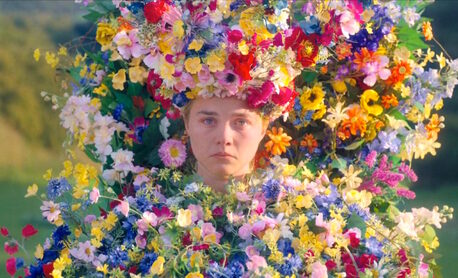B | A group of grad students visits an isolated Swedish community for a ritual that takes place once every 90 years. Directed by Ari Aster Starring Florence Pugh, Jack Reynor, and Vilhelm Blomgren Review by Jon Kissel |

The Swedes have a modern reputation of living in a democratic socialist paradise, where kindness between people and between citizens and their government is the rule of the day. Upon arriving in Pelle’s hometown of Harga, there’s nothing to disabuse Dani et al from that notion, as the townsfolk are happy to see the newcomers and roll out the welcome mat. However, there’s tossed-off lines referencing Vikings, as well as a particularly grisly Viking execution custom later in the film, that reminds the viewer that these socialists and communitarians are the descendants of vicious conquerers, and that bloody past hasn’t been fully purged. In the perpetual daylight of Harga, the people might be hiding their true intentions behind smiles and free booze but their motives are as clear as the various paintings and murals that cover the town and spell out exactly what the foreigners are in for.
Those foreigners are living into a stereotype as well, that of the Ugly American. Mark pees on the ancestral cremation grounds. Josh takes unauthorized pictures of the Harga’s sacred texts. Fellow foreigners Connie (Ellora Torchia) and Simon (Archie Madekwe) freak out during the first death ritual and curse everyone. Midsommar might be elevated horror, but its victims receive a comeuppance like they’re the horny teens of an 80’s slasher flick. One wonders if the same fates awaited them if they were on their best behavior. If they’re marked for death when they pass through the Harga’s doors, why would Aster set them up so blatantly to ‘deserve’ what they get? Did he just want to skewer grad students? If so, I get it, and he does a great job spoofing their competitiveness and pettiness, but the fundamental unnecessariness of this plot is my least favorite part of the film.
What is most necessary in setting up Dani’s big final choice is her relationship with Christian. His behavior is vital towards everything the film is trying, mostly successfully, to say. The scenario that he and Dani are in is played for laughs in a Curb Your Enthusiasm episode, but I find it as terrifying as a Swedish cult. A relationship is on life support, hanging on because neither party has yet mustered up the will to end it, and a tragedy keeps it artificially alive. There’s a version of Midsommar, stripped of the Harga, that has Dani getting seriously ill and Christian feeling like he’s supposed to take care of her, but he brings all of his innate half-heartedness to the job and conflict ensues. Back in the film, he’s incapable of giving her what she needs, and lo and behold, here’s a cult that has a custom of mirroring one’s traumatic emotions and reactions back at them as a way of coping. Dani’s choice to seal her former boyfriend up in a bear carcass and light him on fire isn’t the right one by any means, but it is an understandable one, twisted though it may be.
Midsommar is Dani’s story, and as films about cults go, this is one of the better ones. After watching Once Upon a Time in Hollywood, which heavily features the Manson family, I had a long discussion about what it would take to just turn oneself over to something that an outsider could immediately recognize as exploitative and false. Once Upon a Time in Hollywood doesn’t have any answers on that front, but Midsommar imagines a more credible way in. It took a great deal of pain and violence to destroy her family, and in the logic of the film, it takes an equal amount to forge a new one. Pelle offers Dani a level of emotional intimacy that Christian seems incapable of on his best day. The most emotional moment of the film is Dani, newly crowned May Queen, walking through a joyous reception line of Harga, shining a level of warmth on her that she probably hasn’t experienced in a long time. These people all have ulterior motives to do with genetic diversity and ritual murder, but they make her believe that the camaraderie is real, even as she knows that she’ll have to kill herself almost two decades before reaching Swedish life expectancy and that her descendants might lose a lottery and get burned alive in a yellow house. Midsommar’s big triumph is that it’s all out front, and it makes the viewer buy her choice at the end.
It does feel like there’s a thematically tighter version of Midsommar that has clearer bonds between the various emotional arcs and the rituals themselves, and a director’s cut does exist that might do so. As it exists in theatrical form, the loose, drugged-out nature of the film create a kind of dream logic that, while not airtight, works alongside the high-drama operaticism that Midsommar spends so much time in. This is another horror insta-classic from Aster. It’d be interesting to see him move away from horror and just make the high-stakes domestic drama he so clearly wants to, but with his capacity to create tension and dread, arthouse horror is a fine fit for his talents. B+
 RSS Feed
RSS Feed